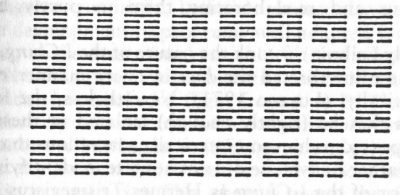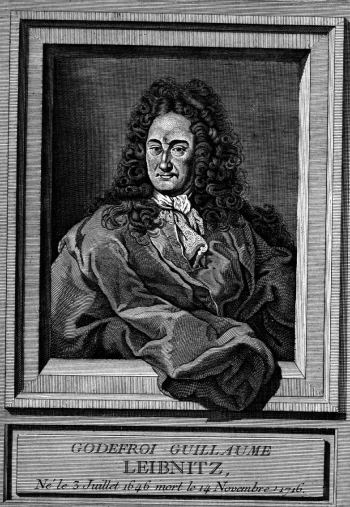Abracadabra: Language, Memory, Representation
Leibniz and the "Universal Character"
Today's reading: Eco, Chapter 14.
Leibniz (1646-1716) was a post-Renaissance Renaissance Man. Professionally he was a statesman, a resident of various courts (Mainz, Hannover, Berlin, Vienna and others for his entire life). But like Da Vinci, his interests ranged across mathematics, philosophy, religion, and engineering, as well as a number of areas of natural science:
No new mathematical principle or natural discovery was too trivial for his attention ... the discovery of phosphorus and its manufacture as a weapon of war; the discovery of European porcelain; the use of microscopes in research; Papin's steam engine, for which he proposed a self-regulating mechanism and the re-use of expended steam; the principle of the aneroid narometer; machinery for the uniform distribution of power in pumps... and proposals for improving clocks, navigation and coinage... (p.8 Loemker ed., Philosophical Papers).
Leibniz was one of the first to build a machine for performing simple calculations; his efforts were often directed at the improvement of nations and the perfection of diplomacy as a tool to achieve peace. In short he was the very opposite of George W. Bush.
One of the things he is most famous for is his independent invention of the integral and differential calculus with Isaac Newton. In his time, the fight between he and Newton, largely carried out in correspondese with Samuel Clarke, one of Newton's disciples, counts among the most viscous and petty disputes in the history of science. Leibniz was the less viscious of the two.
The Universal Character
One of the things that Leibniz returned to repeatedly for his entire life was the invention of a "universal character." This project goes by several names in his works and is related to other work on calculus, logic, combinatorics, encyclopedias and Chinese. Some of the various names, and related fields that are related to this are:
Logic (sometimes Logical Calculus)
Logic of Combinations
Universal Language (general or universal
Character/Characteristic)
Differential and Integral
Calculus
Alphabet of Thought
Encyclopedia
Briefly stated, Leibniz imagined a language which would faithfully (perfectly) present (not exactly re-present) all of the things known about the world. The language, like mathematics today, could then be used to calculate notions, and derive new truths or settle disputes. He imagined a world of diplomacy in which instead of waging war, court councillers would sit down together, elaborate all of the things the knew and wanted and said "Let us calculate."
All of this began with Leibniz's earliest work, the dissertation on the arts of combination, a work that explicitly refers to Llull's art as the basis for his own thinking about combination. Later works are critical of Llull, not because of the theological content (Leibniz' dissertation begins with a proof of the existence of God), but because Llull limited the number of symbols and combinations. Leibniz, as Eco points out, was interested in an art of invention, where new combinations were possible.
Logic and Memory, again
Recall Carruther's explanation of how memory systems worked: they are not always intended simply to store up memories (rote memory) but to in fact create new ideas out of old ones. The rhetorical art of inventio allowed the memory artist to use memory as a kind of tool for generating combinations hitherto unknown in the world.
Leibniz, by his art, intended much the same thing. The crucial difference was that he wanted things (res) to be represented by written symbols that could be manipulated as numbers are or as symbols in algebra are. (It should be said that there is no symbolic logic in existence at this point, and there will not be until Boole re-invents in in the mid-19th century. There is however, a great deal of work in algebra and geometry which Leibniz was familiar with.)
Leibniz tried a number of ways of achieving this. He considered a system of circles, squares and triangles; he considered Egyptian hieroglyphics and Chinese characters; he toyed with the Chinese mystical art of the I Ching; but most of all he tried numbers.
Eco gives several examples.
- 1. The example of Mubodilefa. The substitution of consonants and vowels for numbers and quantities. The creation of such a substitution was never used, but indicated that there could be a connection between words and numbers such that they could be coverted. Thus, the implication is that the search for the "correct" words was the proper domain of a true science.
- 2. In his dissertation on Combination, Leibniz explored the combinitorics that Llull had begun. He considered the possibilities of combination of simple parts (represented by numbers). The combination of any two elements was labeled a com2niation (bi=2), any 3 a con3nation (3=ter, hence conternation), etc. The pure syntactical manipulation was only one part, however, because leibniz intended his system to be applied to various subjects: medicine, chemistry, jurisprudence etc. in order to generate truths from known facts.
- 3. The language of China fascinated Leibniz, he was one of
the first Europeans to see reports from Jesuit
missionaries who returned from China. In particular,
Leibniz was fascinated by the I Ching,
 which he saw
strictly as a combinatoric system, having little access
to the original meanings of the signs. He devised a
system, not unlike a binary logical system that
represented the combinatoric possibilities.
which he saw
strictly as a combinatoric system, having little access
to the original meanings of the signs. He devised a
system, not unlike a binary logical system that
represented the combinatoric possibilities.
Truths of reason vs. Truths of fact
Leibniz' logical calculus, in the end, became a powerful system for manipulating symbols whose meaning is constrained only by number; Umberto Eco sasy: such a logic failed to be a truly universal langauge because it represents only truths of reason vs. truths of fact. Nonetheless, our world today is saturated with logical systems (not the least of which is the embedded algorithms and microprocessors in every thing around us). If logic does not give access to truths of fact, what does?

 Smart, successful, sexy. Leibniz.
Smart, successful, sexy. Leibniz.